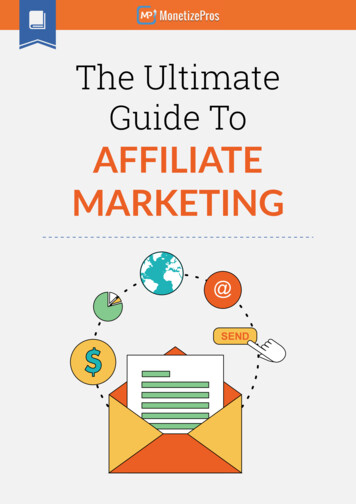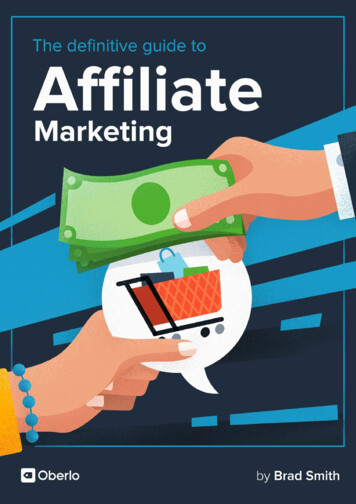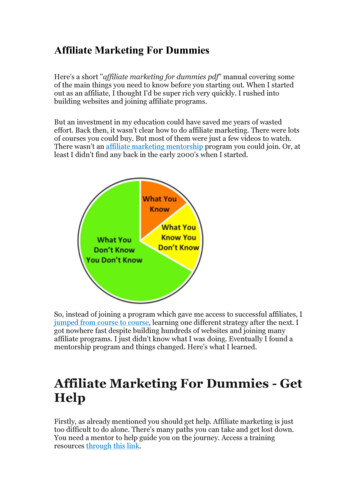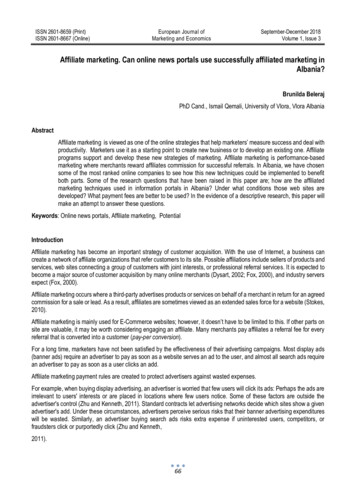
Transcription
The UltimateGuide ToAFFILIATEMARKETING@SEND
This guide covers affiliate marketing, including an introduction to this monetizationtechnique, a review of the most popular implementations of affiliate marketing, andhighlights of the top affiliate ad networks.This guide will be much more useful if you already have your own blog. In case you don’t,check out our post titled “How to Create a Blog and Make Money Online“.INCLUDED INTHIS GUIDEwhat is affiliate marketing?three factors that determine affiliate marketing success17 articles to read before you start affiliate marketing5 proven affiliate marketing strategieshow to pick an affiliate marketing offerhow to establish a direct affiliate marketing relationshiptop affiliate marketing networks01020304050607
01WHAT ISAFFILIATE MARKETING?Affiliate marketing has become a massiveFor each product the affiliate sells, theyonline industry over the past several years,receive a portion of the proceeds from theemerging as both an effective way formerchant. It’s effectively an outsourcedmarketers to sell their products andsales team. At its core, affiliate marketingservices and for publishers to monetizeis just that simple.their audiences. Despite the popularity ofaffiliate marketing, many publishers stillOffline Examplearen’t aware of exactly what affiliatemarketing is or how it works. In someWhen I was a child, my school would havecases, these publishers are gatekeepers tofundraisers that involved us goingan audience that could be very effectivelydoor-to-door to sell magazinemonetized through affiliate marketing,subscriptions (magazines were glossy,meaning that they’re passing up ansoft-cover publications that would beattractive revenue stream.mailed to a subscriber’s house on a weeklyWhat it is (and What it isn’t)At its heart, affiliate marketing is an onlineversion of a sales structure that has beenhappening offline for decades. In itssimplest form, it involves three primarycomponents: A merchant, or someone with a productor service to sell An affiliate, or individual with thewillingness and ability to sell that productto a particular audience A product or serviceor monthly basis). I didn’t realize it at thetime, but I was right in the middle of anaffiliate marketing scheme. The magazinecompanies had products they wanted tosell. Schools had the ability to sell theseproducts. And for every subscription sold,the magazine companies gave a slice ofthe proceeds to the school. (In thisexample, there’s actually a secondary laterof affiliate marketing; the schoolseffectively outsource the actual selling tothe students, in exchange for prizes thatcome with meeting certain sales figures.)
Online, affiliate marketing works generallyVisitors x Click Rate (on Affiliate Links) the same way – except that theReferred Visitorsdoor-to-door sales approach is replacedby strategies more suited to a digitalReferred Visitors x Conversion Rate xmarketplace. In most instances, theAverage Purchase Price Referral Revenueaffiliate marketing process works asfollows:Referral Revenue x Commission % Affiliate Marketing Revenue1. Visitor to a publisher’s website clicks an“affiliate link” that takes them to a thirdThe success of an affiliate marketingparty landing pagestrategy depends on how many referralsyou’re able to send to merchant sites and2. Visitor makes a purchasehow well these referrals convert (hencethe bolding of these factors above). The3. Affiliate (publisher) gets a commissionmore relevant and appealing the offers youbased on the value of the products andhighlight on your site, the higher both yourservices purchased at the partner’s siteclick and conversion rates will likely be. Ifyou’re running a travel blog, you probablyIn other words, affiliate marketing is a kinddon’t want to be featuring affiliate offersof cost-per-action (CPA) advertising. Thefor baby products; replacing them withpublisher makes nothing for highlighting aaffiliate links to cruise packages wouldpartner’s product on their site, and theyprobably result in a higher referral rate.make nothing for getting a visitor to clickthrough to that site. The commission isFor more, see the next section on Threeonly earned when a sale is completed.Factors That Determine Affiliate Marketing Success.Affiliate marketing is facilitated by“affiliate links” that allow merchants totrack where their customers originate. Inother words, it’s possible (and actuallyvery simple) to know which revenue camefrom a specific affiliate and tocompensate that affiliate accordingly.Affiliate Marketing EconomicsFor publishers, the affiliate marketingrevenue equation looks something like this(we’ve bolded the factors that are mostwithin your control in optimization efforts):Appeal of Affiliate Marketing(to Advertisers)Advertisers love affiliate marketingbecause it involves minimal risk. If asufficient margin is built in ascompensation for the affiliate, it becomesimpossible to lose money. That’s becauseaffiliates are generally only paid when asale is completed (i.e., a lead isconverted). Advertisers (or “merchants”)pay nothing for leads that don’t convert.
Compare this to a CPM-based advertisingcampaign, where an advertiser pays afixed amount to get a fixed number of adimpressions. (E.g., they may pay 10,000to have 1 million ads shown on a publishersite, or a 10 CPM.) That campaign maybe unsuccessful however if the adimpressions don’t convert into clicksAppeal of Affiliate Marketing(to Publishers)Affiliate marketing is very appealing tosome publishers as well, because it canallow them to make considerably moremoney than they would under anand/or eventual sales.alternative monetization strategy. ThoughUnder most affiliate marketingvary a bit, in general affiliate payments willarrangements, advertisers only pay forconverted leads. There is basically no waythey can lose money or get a negative ROIwith this marketing method. Each newsale generated may have a thin marginafter the affiliate payment is made, but it’spossible to structure in such a way thateliminates the possibility of a loss.Some merchants will pay for actions thatdo not involve the transfer of money (i.e.,something besides a sale of a product orservice). For example, many merchantspay affiliates for referred visitors thatultimately sign up for a newsletter or otherfree product.the specifics of payout arrangements canbe significantly larger than the revenuegenerated from a click under a CPC pricingarrangement (or the effective CPC under aCPM arrangement). For high marginproducts such as e-books, for which thereare no material costs, affiliate margins canbe as 50% of the total purchase price. Soit’s not unheard of for affiliates to generate 100 or much more from each referral.To explain this a bit further, let’s considera real life example. Below is a screenshotfrom AffiliateTip.com, a popular blog runby affiliate marketing guru Shawn Collins.In his right sidebar, he has a number ofaffiliate links for products such asHootSuite, Dropbox, and Bluehost:
Alternatively, there could be a traditionalThe end result in this hypothetical is 20160 600 display ad unit here. From ain revenue–significantly more than the 3network, that ad unit might earn theor 4 that could be earned from traditionalpublished an effective CPM of 3 or 4.display advertising.If the optimal affiliate marketing links areused instead, the payout can be muchOf course, the revenue per visitor is highlyhigher.dependent on the click and conversionrates. But the hypothetical above shouldLet’s assume that the aggregate click rateillustrate that if you’re able to find quality,on this affiliate link section is 1%, that 20%relevant affiliate offers, affiliate marketingof referred visitors convert, and that thecan be a very attractive monetizationaverage commission is 10. For everyopportunity.1,000 visitors: 10 click through to an affiliate link 2 end up purchasing something froma merchant 20 in revenue for the publisher isgenerated
Affiliate Marketing In Action TV Review Site: This site compilesprices for products at various WebAffiliate marketers can use a number ofretailers, including an affiliate link to all ofstrategies to sell to their audience, withthem. If a visitor to this site ultimatelydifferent approaches making the mostclicks through and makes a purchase, asense for different niches and productcommission is earned.lineups. These strategies include: Coupons Product Reviews Product Rankings Product Aggregation / Price Comparison Only Cookware: This is one of severalsites run by Amazon “super affiliates”Paula and Wanda. Their reviews featureaffiliate links for visitors to purchase theproducts on Amazon, which nets them acommission in the neighborhood of 8.5%.For more on each of these approaches, aswell as examples of them in action, checkMany publishers would be surprised at theout our feature on Five Proven Affiliatedepth of the affiliate marketing industry;Marketing Strategies.it’s a lot more than e-books and amazonaffiliates. Commission Junction, one of theBelow are some real life examples oflargest affiliate networks, has an impres-affiliate marketing strategies in action:sive list of advertiser verticals: Review: 31 Days to Build a Better Blog:Note the affiliate links to the landing pagewhere this e-book can be purchased. Forevery referred purchased, this publishermakes 40% of the total purchase price. Electronic Drum Kit Reviews – This isyour typical Amazon associates website.They’ve got a variety of articles aboutdrumming gear as well as actual productreviews and a long “buyer’s guide” on thehomepage. They receive anywherebetween 4-8,5% per sale.
Bottom LineAffiliate marketing is a fairly simple concept that can be implemented in a countlessnumber of ways online. Though it’s not as familiar or easy to set up as display advertisingstrategies that dominate many publisher monetization strategies, there is the potential fora big payoff if a bit of work is done upfront.
02THREE FACTORS THATDETERMINE AFFILIATEMARKETING SUCCESSAs affiliate marketing has become a multi-billion dollar industry over the past severalyears, it’s also become increasingly sophisticated. Across the seemingly endless nichesare a variety of strategies for generating revenue. With more merchants, offers, andanalytics, there’s a lot to the affiliate marketing business.But while the details have grown increasingly complex, the big picture remains incrediblysimple. Success in affiliate marketing ultimately depends on how well you executethree tasks.Affiliate Marketing For DummiesIf you’re an affiliate marketer, you have a chance to make money every time someoneopens up a Web browser. To the affiliate marketer, below is a diagram of how the flow ofevery Internet engagement unfolds.
You make money on the path that includesIf your website doesn’t have much trafficthree green boxes; on all others–the vastto speak of, there’s probably not a bigmajority of scenarios–you get nothing. Soopportunity for you now in affiliateat its simplest, affiliate marketing successmarketing. Focus on producing highcomes to those who maximize the numberquality content, building some links, andof positive outcomes down the flowgetting a recurring stream of visitors tochart above.your site. But if you have a website that isThree Key Factorsalready attracting a significant number ofvisitors from referring sites, organicsearch, and direct visits, affiliatePut another way, think of affiliatemarketing could be a logical way tomarketing as this formula:monetize.Revenue Visitors x Click Rate xFACTOR #2: CLICK RATEConversion Rate x CommissionThis is where we put the “marketing” inImproving any one of the variables on theaffiliate marketing. It’s up to you as theright side of this equation will increase theaffiliate marketer to make sure that yourdollar amount on the left side. So affiliateaudience sees the affiliate links and offersmarketing really boils down to optimizingyou have on your site. You can’t simplythree factors:throw them into the right sidebar and hopethat your audience seeks them out andFACTOR #1: VISITORS / TRAFFICclicks on them. There’s a great deal thatyou can do to increase the likelihood thatIn order to make money from affiliateyour visitors click on the links and get inmarketing, you need to convert a visitor tofront of the affiliate offer.your site to a paying customer for yourmerchant partner(s). Obviously, the moreThis topic is extremely broad; there arevisitors you have (i.e., the greater thecountless strategies for increasingtraffic to your site), the more chances youvisibility (and ultimately click rate) on yourhave to make an affiliate referral.affiliate links, ranging from incorporatinglinks into your content to sending emailsBuilding up a large base of traffic is into your newsletter list. Check out some ofitself a huge challenge. There’s an over-the affiliate marketing gurus on our Bestwhelming amount of content on the WebMonetization Blogs overview for andedicated to attracting visitors to yourextensive supply of tips and tricks forwebsite, and we won’t go into any detailboosting the number of clicks your affiliateon the topic here. (Check out SEOmoz orlinks receive.Search Engine Land if you really want toread more).
John Rampton has some ideas onincreasing click rate, and Zac Johnsonhas five simple ways to boost click ratesas well.Commission vs Conversion %There’s often a trade-off between thequality of a product and the commissionbeing offered. And it’s tempting to gravi-FACTOR #3: CONVERSION RATEtate toward the partners and products thatpay you the most per conversion. But ifConversion rate refers to the percentagethose products are unlikely to convert,of referrals sent who ultimately completethey might not be the best fit.the desired action (e.g., purchasesomething from Amazon).Consider two products:This is one area that is often overlooked Product A: 100 commission to affiliatesas an “out of my hands” part of theaffiliate marketing funnel. Once you’vesent a visitor to the merchant site, all you Product B: 25 commission to affiliatescan do is cross your fingers and hope theyProduct A looks like the winner, right? Notultimately complete whatever action isnecessarily; your expected revenue fromnecessary for you to get your commission.promoting this product depends on theThat’s partially true I suppose. But youlikelihood of conversion. Suppose thehave more input here than you mayconversion rates look like this:realize.Part of the affiliate marketing gameinvolves picking out merchant partners Product A: 1% Product B: 5%and products to promote. If you’reFor each affiliate click you send to Productpromoting a crap product, you canA, you can expect 1.00 in revenue. Forprobably send some traffic through theeach sent to Product B, you can expectaffiliate link by doing a good job of 1.25 in affiliate revenue.marketing it to your audience. But oncethey get to the merchant site and areDon’t get blinded by simply commissions.disappointed in what they see, they’reFinding relevant, quality products toprobably going to abandon.promote is one of the most importantparts of the affiliate business.If you’re promoting a quality product thatyou think delivers great value to youraudience, they’re much more likely tocomplete the purchase once they’veclicked.
Bottom LineFocusing on any one of these areas increases your chances of affiliate marketing success.But optimizing one area when another is sub-optimal won’t deliver the results you want. Inother words, the real success and revenue comes when all three are executed successfully.For example, building up a big base of traffic won’t deliver much of a reward if you’reworking with the wrong affiliate offers.Similarly, doing a great job marketing the idealoffers to an extremely small traffic base won’t translate into much revenue. Each of thesethree points must be implemented and improved together, or else you won’t see results.There’s obviously a lot of work that goes into each of the three points above; building upsubstantial traffic takes months (or even years) of effort, and finding the right affiliatesinvolves never-ending research.
0317 ARTICLES TO READBEFORE YOU STARTAFFILIATE MARKETINGBefore diving into affiliate marketing, it’s wise to spend some time reading up on thechallenges, opportunities, and best practices. This e-book will teach you most of what youneed to know about affiliate marketing, but for those interested in furthering theireducation, we’ve highlighted 17 additional articles from other writers.Working your way through all of the articles below will take you quite a while, but you’llend up with a complete understanding of the mechanics, opportunity, and challengesassociated with monetizing a site via affiliate marketing. Click here to read the 17 affiliatemarketing articles.
045 PROVEN AFFILIATEMARKETING STRATEGIESAffiliate marketing is one of the most popular monetization techniques for nichepublishers in 2014, being used by hundreds of thousands of sites in a wide variety ofverticals. Affiliate marketing is popular for a number of reasons, including the potential forsuccess with a relatively small audience and the deep pool of affiliate partners willing topay to acquire new customers.Affiliate marketing also is a very broad term; under this umbrella there are several differentstrategies that can be employed to generate affiliate revenue. The most appropriate andlucrative method (or methods) can depend on a number of factors, including your site’sniche and characteristics of your audience. Below is an overview of some of the mostpopular affiliate marketing implementations, along with examples of each. Click here toread more about the proven affiliate marketing strategies.
05HOW TO PICK AN AFFILIATEMARKETING OFFERFor sites looking to monetize their existingtraffic through affiliate marketing, a majordeterminant of success is picking the rightoffers to run. The difference in earningsfrom a bad offer and a good one can beenormous. Unfortunately, finding the“right” offer isn’t exactly easy; if you’reusing an affiliate marketing network suchas Commission Junction (now part ofConversant), SharesASale, or LinkShare,you will have literally thousands of affiliateoffers available to you.As with many aspects of Web monetization, the exact strategies will vary fromsite to site. There’s no universally superioraffiliate marketing offer or merchant.There are, however, some general guidelines on factors to consider when evaluating potential affiliate marketing offers.We’ll dive into several of these below.We’re using screenshots from ShareASalethroughout this article to illustrate theprocess, but the tasks and terms will begenerally similar across the major affiliatemarketing networks.Relevant MerchantsThe major affiliate networks will havethousands of offers available to you. Thevast majority of them won’t be appropriatefor your site, in the sense that theproducts or services advertised aren’trelevant to your audience.One of the major factors that determinesaffiliate marketing success is the clickrate on your site, or the percentage of yourvisitors who click on an affiliate marketinglink. The more targeted and relevant theoffers you present, the more likely yourvisitors are to click through to themerchant site.Every network offers affiliates a way tofilter through the numerous offerspresented. Take the time to go through thevarious categories or search for specificmerchants that you think would do well onyour site. There’s no set of rules forfiltering through the options; you’llultimately need to rely upon your familiaritywith your audience and your gut feelingsabout what types of offers will perform.
05HOW TO PICK AN AFFILIATEMARKETING OFFERIf your site is more general in nature (e.g.Though commission rates are obviouslya personal blog or general news site), youimportant, this number definitely needs tomay have a bit more flexibility and abe considered in connection with the typedeeper pool of initial candidates.of offer. A merchant offer that pays 50%commission seems very attractive in aCommission StructureThe commission is generally thepercentage of a sale that is paid to theaffiliate for referring a customer. Thecommission percentage can range fromthe low single digits to more than 50%.(E-products generally have the highestcommissions since the margins are closeto 100%.)vacuum, but if the product offered isn’trelevant to your audience and the creativeis no good the results will probably beuninspiring.In other words, the equation for affiliatemarketing revenue has several variables:Revenue Visitors x Click Rate xConversion Rate x Average Sale Price xCommission
In many cases, offers with the highest commission may result in sub-optimal click orconversion rates. The commission percentage only comes into play if you actuallygenerate sales.Some offers will feature unique wrinkles in the commission structure:Multi-Tiers: While most commissions are a flat fee, some offers will pay out differentpercentages depending on sales volume.Bonuses: Some merchants will offer bonuses for reaching certain sales thresholds, creating another opportunity to generate revenue for major affiliates. For example, a companymay offer a 500 bonus to affiliates that generate 25,000 in sales in any given month.While only a very small percentage of affiliates will ever hit this target, it can translate to ahigher effective commission rate (the extra 500 on 25,000 in sales is effectively anadditional 2% commission). Here’s an example of a bonus commission offer (in this case, 625 for hitting the 25,000 mark and 1,250 for generating 50,000 in monthly sales):
The presence of multi-tier pricing and bonuses can obviously increase the overallattractiveness of an offer.Creative OptionsThe hardest aspect of an affiliate marketing offer to evaluate may also be the mostimportant. Your ability to drive traffic to merchant sites via affiliate links is one of theprimary revenue drivers, and it depends in large part on the tools you’re given. These toolsare the advertisements merchants have available for affiliates to use on their site. Thebetter the ads are, this more clicks they will get.Networks will generally provide a preview of the creative files a merchant has before yousign up. There are a couple elements of ads to evaluate:1. Technical aspects, such as size2. Overall qualityThe first point is straightforward enough; affiliates need to identify offers that include adsthat will fit easily into their site. For example, if your site has only 300 250 ad units you’llwant to stick only to offers that have a 300 250 ad.Harder to evaluate is the quality of the ads.Generally, larger and wealthier merchants will be able to spend the time and money toproduce a wide variety of high quality ads.
Cookie LengthAffiliates receive credit for a conversion by placing a cookie on the computer of visitorsthey send to a merchant site, allowing the network to attribute sales to specific partners.Many merchants will give credit for a sale to an affiliate even if the sale comes after theinitial visit to the site. For example, assume:1. Visitor clicks affiliate link on publisher site;2. Visitor browses merchant site, but doesn’t buy anything;3. Visitor returns to merchant site (by typing in URL) a week later and completes purchase.Many merchants will still give credit for this sale to the affiliate, even though the visitorcame directly to the site and not through an affiliate link when they completed theirpurchase. This is a fair solution in many cases, since many customers take time to make adecision and commit to a purchase. In the scenario above, the affiliate still provided avaluable service to the merchant–getting the customer to their site–and deserves to becompensated for that.Here’s an example of a cookie that lasts for almost 6 months:A 30-day cookie is the standard, but there can be quite a bit of variation here. Some cookies expire after just a week, while others run indefinitely. From an affiliate perspective, thelonger the cookie length the better.
Estimated EarningsReversal RatesMany networks provide metrics on theReversals refer to completed sales forearnings of other affiliates with certainwhich the commission is cancelled andoffers. The standard metric is EPC, orreturned. This can happen for a number ofearnings per click. This unit is generallydifferent reasons:presented as the total earnings for every100 clicks received. An EPC of 97 means1. The order was cancelled by customerthat for every 100 clicks on an affiliate link(and refunded by merchant);to that merchant, affiliates are generating2. The transaction was a duplicate (i.e., 97 in revenue.customer card charged twice);3. The transaction was fraudulent;EPC can be converted to RPM, or revenue4. A violation of the merchant’s affiliateper thousand impressions, as follows:policy was committed.RPM (EPC / 100) x (CTR x 1,000)Reversal rates are generally in the lowsingle digits; it’s standard for about 1% ofThis assumes that you know (or can esti-transactions to be reversed. If you seemate) the click rate that an affiliate offeroffers with extremely high reversal rates,will get on your site.that could be a red flag. It doesn’t meanyou should necessarily stay away, but it’sThis metric is a way of summarizing theworth understanding why so manyconversion rate, average ticket price, andtransactions are returned. For example,commission percentage. It does not takethere’s something strange going on withinto account the click rate that an offerthis merchant:will receive. So while EPC is certainly auseful stat to consider when evaluatingpotential affiliate offers, it must beconsidered alongside the click rate anoffer will receive. A great EPC combinedwith a bad click rate won’t translate togreat earnings. (In other words, thehighest EPC isn’t necessarily the bestoffer.)A lower reversal rate equates to higherrevenues.
Pricing ModelsAffiliate marketing compensation arrangements generally fall into one of three categories:1. Pay-per-sale (most common)2. Pay-per-lead (somewhat common)3. Pay-per-click (pretty rare)The pay-per-sale and pay-per-click structures should be pretty obvious. Under apay-per-lead arrangement, affiliates can get paid even if the merchant doesn’t generateany revenue. In most cases, this would involve earning a commission when a referralstarts a free trial to a service. Even if they never pay for that service after the trial expires,the commission is earned.You may eventually determine that certain types of pricing arrangements work better onyour site and with your audience. Excluding pay-per-sale offers, however, will dramaticallylimit the pool of options at most affiliate networks.Bottom LineSuccess in affiliate marketing ultimately comes down to finding the right offers for youraudience, and effectively funneling your traffic to your merchant partners. Picking therelevant offers that feature attractive commissions is a tough process, but one that isworth spending a considerable amount of time on.
06HOW TO ESTABLISHA DIRECT AFFILIATEMARKETING RELATIONSHIPThe two primary players in any affiliateIn this article, we’ll explore the options formarketing arrangement are theaffiliate marketers looking to cut outcontent - creating affiliate and thenetworks entirely and establish affiliateproduct - selling merchant. But as affiliaterelationships directly with merchants whomarketers know, networks such aswill compensate them for any salesCommission Junction and LinkShare aregenerated.key components of the “ecosystem” aswell. Just as many sites that monetize viadisplay advertising attempt to establishdirect relationships with advertisers andcut out ad networks, successful affiliatemarketers may wonder about eliminatingnetworks and working directly withtheir merchants.Affiliate Marketing RefresherTo understand the potential value inestablishing direct relationships withmerchants, a quick refresher course on theeconomics of affiliate marketing may beuseful. We like this visual as a way tosummarize:
What the chart above doesn’t show is theWhenever there’s a network in the middle,role of the affiliate marketing networkthe payout to the publisher will be(e.g., Commission Junction or LinkShare).diminished by the “cut” that player takes.From the publisher’s point of view, theSo there is an opportunity to make moreaffiliate network is involved very early onmoney in affiliate marketing by cutting outin the process, generally supplying the adthe middleman network and keeping thecreative and affiliate links used to referentire commission intact for the affiliatetraffic. They’re also involved at the last(publisher).(and most important) step in the process:a portion of the commission earned by theBut establishing direct affiliate marketingaffiliate goes to the network who matchesrelationships is extremely challenging forthem up with merchants and handles thea number of reasons, which we’ll get intovarious administrative functions.below. While there are certain instanceswhen a direct relationship makes sense,most affiliates will be better off acceptingthat networks are part of the equation andfocusing on finding the right merchantsand maximizing referrals.
What Do Affiliate Networks Do?Direct Options Are LimitedIf you’re attempting to establish directThere is a reason why many majoraffiliate marketing relationships, it’smerchants prefer to utilize affiliateimportant to fully appreciate the value thatmarketing networks instead of setting upnetworks provide. To over-simplify, thetheir own infrastructure. Just as thenetwork exists to:administrative burden can becomeoverwhelming for publishers with multiple1. Match up merchants and affiliates;relationships in place, it can be too time2. Handle the administrative aspects of anconsuming for merchants as well.affiliate-merchant relationship;Maintaining direct affiliate relationships3. Protect affiliates.involves building out an infrastructure totrack referrals, calculate commissions,The “matchmaking” service–offeringand process payments. While that
Affiliate Marketing For Dummies If you’re an affiliate marketer, you have a chance to make money every time someone opens up a Web browser. To the affiliate marketer, below is a diagram of how the flow of every Internet engagement unfolds. THREE FACTORS THAT










